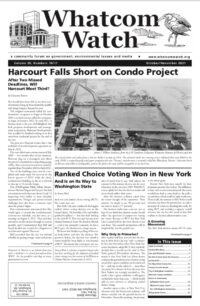The grants went to 105 projects in 29 of the state’s 39 counties. The grants will pay for work to restore salmon habitat.
Lummi Nation Grant Awarded: $100,000
The Lummi Nation will use this grant to study the feasibility and develop conceptual designs for a restoration project on the South Fork Nooksack River, southeast of Saxon.
The Tribe will hire an engineering firm to hydraulically model design alternatives, which may include logjams, a road set back, removal or covering of riprap, raising a bridge to remove a pinch point, excavation of side channels, and riverbank plantings. Alternatives will be evaluated on how they benefit Chinook salmon. Stakeholders will help select a preferred alternative to be developed into a conceptual design. The goal is to restore spawning, rearing, and holding habitat.
The project will benefit Chinook salmon and steelhead trout, both listed as threatened with extinction under the federal Endangered Species Act, in addition to coho salmon, a federal species of concern, and chum salmon.
Nooksack Indian Tribe Grant Awarded: $643,103
The Nooksack Indian Tribe will use this grant to restore 0.4 mile of the South Fork Nooksack River, north of Acme. The tribe will place 14 logjams in the river and remove at least 125 feet of riprap from the historic channel migration zone. Adding logs to a river creates places for fish to rest, feed, and hide from predators. It also slows the river, which reduces erosion and allows small rocks to settle to the riverbed, creating areas for salmon to spawn. Finally, logs change the flow of the river, creating riffles and pools, which give salmon more varied habitat.
The logjams and disturbed areas will be planted with native vegetation. Planting trees and bushes along a shoreline helps shade the water, cooling it for fish. The plants also drop branches and leaves into the water, which provide food for the insects salmon eat. Finally, the roots of the plants help keep soil from entering the water, where it can smother fish spawning gravel.
This is the first phase of the larger South Fork Nooksack Homesteader Reach Restoration Project, which will place 24 logjams in the river and enhance existing logjams to restore migration, holding, spawning, and rearing habitat for early Chinook salmon.
The project will benefit Chinook salmon and steelhead and bull trout, all of which are species listed as threatened with extinction under the federal Endangered Species Act, as well as coho salmon, a federal species of concern, and chum. pink, and sockeye salmon.




























